Ever since a young Steven Spielberg shunned the comforts of a Hollywood studio to shoot his film Jaws on location on Martha’s Vineyard, sharks have been embedded into the cultural imagination of the Island. A walk down Circuit Avenue in Oak Bluffs confirms that the killer great white’s shadow looms large, his toothy maw plastered on everything from baby bibs to souvenir shot glasses.
Until recently, sharks remained just that – imagination. For the last several decades, white sharks – also known as great whites, the species made famous in Jaws – have rebounded in the North Atlantic thanks to greater conservation efforts and increased food sources. But even as they shut down beaches on the Cape and Nantucket, white sharks rarely were seen in Vineyard waters – and when they were spotted, they were thought to be just passing by. In fact, beach closures due to sharks were so rare that the Edgartown Parks Department didn’t bother to keep a close record of shark encounters.
“We would get about one or two per summer, if any at all,” Edgartown parks administrator Jessica McGroarty said.
Until last summer, when Edgartown’s South Beach closed upwards of eight times due to alleged shark sightings. During peak tourist season, life imitated art as lifeguards and beach patrol rangers scrambled to keep beachgoers out of the water whenever a dagger-like fin broached the waves. Once a fin was spotted, the lifeguards would inform McGroarty, who would then coordinate communication between the South Beach rangers, the neighboring rangers at Norton Point, and the pilots flying out of nearby Katama Airfield to determine the direction of the animal, identify the species, and keep individuals out of the water until the coast was clear.
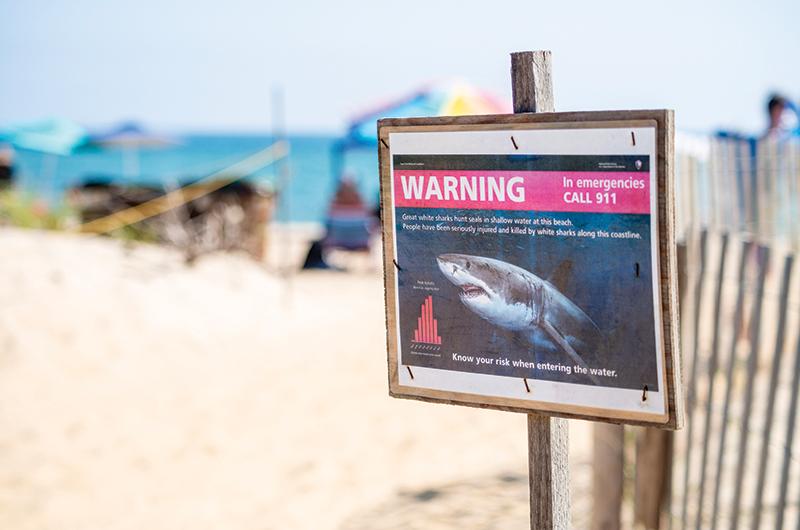
Their most frequent aerial collaborator is Mike Creato, an aviator who has been flying his bright red biplane over the Katama shore for nearly thirty years. Like McGroarty, he has seen an increase in white sharks in the past year.
“I fly up every day from May to October, sometimes later depending on the weather,” Creato said in his Katama hangar. As those months are the same period white sharks are known to inhabit Cape waters, his frequent airtime makes him an ideal resource for beach rangers hoping to get a better look at an “unidentified swimming object.”
Nate Newcomer, South Beach’s assistant head lifeguard, insisted, however, that the scenes on the beach did not resemble any cinematic depiction of mass panic. Newcomer is a college student from Connecticut and has been coming to the Island every summer since he was a young child. This past year was the first one in which a formal shark management strategy had been a part of his summer plans.
“Everyone is pretty understanding,” he said, standing on the beach one sunny day toward the end of last summer. For the most part, Newcomer hasn’t faced much resistance from tourists looking to swim at their own risk. “Every now and then you get…someone, though,” he said, shifting slightly. “We’ve seen it all.”
Shark sightings have even interrupted a few early morning lifeguard trainings, he said, prompting the lifeguards themselves to haul out of the water until the telltale fin passed. When asked if he is scared of sharks, Newcomer was adamant that he was not. Asked if any of the other lifeguards are scared of sharks, he smiled and paused, looking up at his colleagues on the lifeguard tower. “I’m not going to call anyone out,” he said.
Given the recent spike in shark sightings, McGroarty, in her professional capacity as parks administrator, believes that the best policy is to be prepared. That includes implementing a new Edgartown Parks Department shark sighting policy. New hires will be trained on the protocols, which include a minimum of one hour’s beach closure from the time of the most recent confirmed sighting, marking out the area of the sighting, and stationing beach rangers at each end of South Beach to warn visitors of a closure.
In other words, 2022 could well have been an anomaly, but the team at the beach isn’t counting on it.
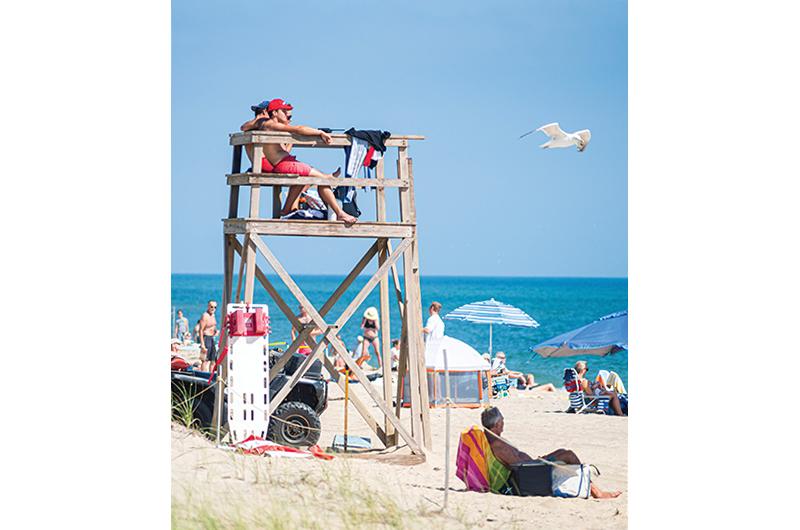
“It was definitely abnormal,” McGroarty said of last summer’s increase in shark sightings. “But we do expect those numbers to continue.”
For prices ranging between $349 to $839, Creato will take up any willing participant to view the Island from a thousand feet above. On a warm, clear day in September, I hopped a ride to try and get a glimpse of a white shark myself. There in the air behind the arrhythmic roar of the biplane engine, Creato opened up about his shark encounters.
“I once saw a great white get close to a man on a paddleboard, but he didn’t end up attacking,” he said over the plane’s World War II–era radio system. As we banked up over Katama, the crescent outline of Nantucket emerged into view. Creato pointed out speckles and shadows that turned out to be schools of fish. Sharks can hear the plane whirring, he said, and will often retreat deeper into the water if he tries to fly the plane lower for a closer look.
“I’ve never seen a shark make the move,” he said. “Although I’ve probably interrupted quite a few seal attacks.”
He went on to tell the story of a man in Australia who went scuba diving with some friends and saw a large mass dart next to him from the corner of his mask. “The next thing he saw was his friend bitten in half,” he said, and a white shark swimming through the blood-stained water. Creato isn’t scared of sharks, but he’s no fool.
“I don’t wear my seal skin anymore,” he said.
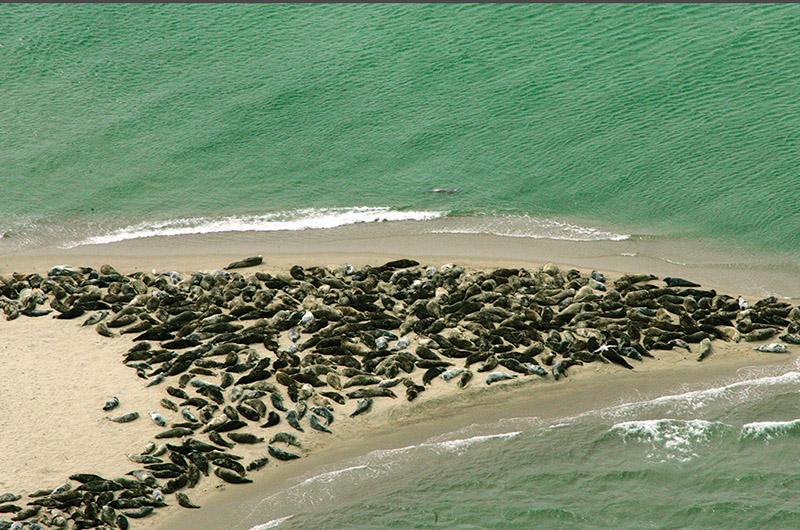
When the tide is low, Creato often sees dozens of seals gathered on the shoals between Muskeget Island – a spit of land located eight miles southeast of Chappaquiddick – and the Vineyard, usually joined by one or two looming white sharks. The day we flew by, however, the sandbar was empty except for two gray seals, each the size of a plump grain of rice.
Fifty years ago, the sight of two seals would have been newsworthy. After decades of bounty hunting and commercial sealing, an estimated 135,000 seals had been killed or disappeared from Cape Cod and the Islands between 1890 and the late 1960s. The species was driven nearly to extinction. The Marine Mammal Protection Act, which was passed by congress in a bipartisan effort in 1972, outlawed the killing of seals and other marine mammals. Since then, the seal population has rebounded to more than 30,000 adults and pups on Cape Cod shores.
These numbers have had a direct effect on the white shark population on the Cape, drawing in adults and juveniles to feed from May to early December.
Despite their increased numbers on the Outer Cape as a whole, white sharks’ presence around the Island is almost exclusively limited to the South Shore due to their migration patterns. As they travel north up the Atlantic coast to the Gulf of Maine, they pass by Noman’s Land – which has seen a marked increase in seal populations over the past decade – as well as Muskeget Island. White sharks have also been spotted in recent years near the largely uninhabited Elizabeth Islands, which have regained a healthy seal population.
White sharks are not the only shark species experiencing a revival. Although the seal population increase is one answer, experts are quick to point out that there are multiple factors driving what might look like a feeding frenzy.
Greg Skomal is a marine biologist for the Massachusetts Division of Marine Fisheries (DMF) and a shark expert based in New Bedford. Formerly stationed on the Island at a branch of the DMF, Skomal has spent the better part of forty years studying white shark movements in the Atlantic Northeast. While shark encounters are nothing new to the Vineyard, Skomal has observed an uptick in anecdotal sightings in recent years.
“There’s a number of factors driving this perception that there’s more sharks,” he said. “And it’s probably because there are more sharks.”
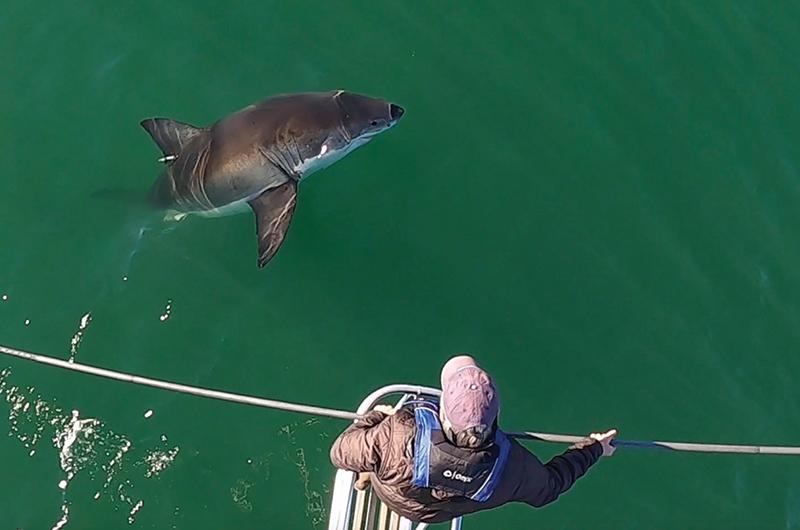
Thanks to greater conservation efforts, shark species of all kinds have rebounded in the past several decades, Skomal said. Regulations are complicated and vary from species to species depending on the degree to which they have become threatened or endangered: white sharks were designated as protected in most federal waters in 1997 and in Massachusetts waters eight years later.
In addition to conservation gains, warming temperatures might also be luring more shark species to North Atlantic waters. Last August, aerial footage of a hammerhead shark went viral in the Facebook group Islanders Talk. The video, captured in Katama, showed a single hammerhead chasing a sting ray mere feet from the shore. The news did not surprise Skomal, who noted that hammerheads have historically been recorded off the Vineyard and have also had increased sightings in the Northeast the past several years.
“We already know that some of these tropical species can wander north in the summertime, depending on water temperatures,” he said. “But as climate change elevates these water temperatures, it’s more likely to happen.”
With greater protections and plentiful food sources, larger shark species such as brown sharks or sandbar sharks – commonly pulled up by anglers out at Wasque, on Chappaquiddick – have also increased, leading some people to confuse them with white sharks.
Skomal cautioned that great white sharks are especially difficult to spot by their dorsal fin, since they tend to swim deeper into the water. “We’ve seen literally thousands of white sharks off the Outer Cape, and I can probably count on two hands the number of times I’ve seen a dorsal fin out of the water,” he said. “I’m obviously not doubting that they’re seeing something out there, and they very well may be sharks. I’m just curious as to the species.”
What’s more, shark sightings are hardly an indicator of population, since one could be seeing the same shark over and over, and one almost certainly isn’t seeing all the sharks in a specific area.
To help raise awareness of the presence of sharks in local waters, the Atlantic White Shark Conservancy, an organization that partners with Skomal and the DMF, has created the shark-tracking app Sharktivity. Crowdsourcing data from researchers, safety officials, and app users, Sharktivity tracks white shark sightings off the coast of New England, marking each encounter with a white fin icon. Signs posted around South Beach last summer encouraged beachgoers to download the app to stay abreast of white sharks’ movements, even though the vast majority of sightings tend to be logged from the Cape.
In previous years, Skomal has also worked with Vineyard scientists to set up acoustic receivers that can gather data on tagged sharks’ movements in Island waters. Through those receivers, Skomal confirmed that white sharks do pass by the southern side of the Island on their way north to Cape Cod.
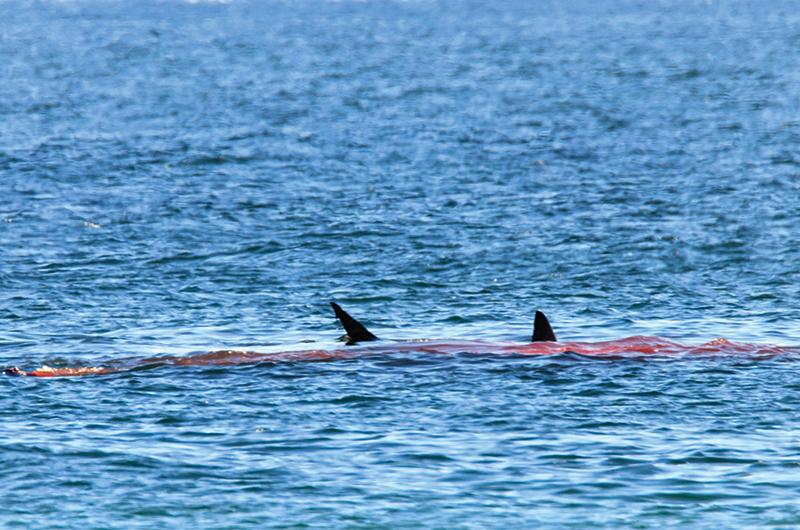
“They don’t exhibit any sense of residency,” he said. “In other words, they’re not staying in any particular area, at least not where our receivers are. And then they pass through again at the end of the season, in September, October, even November.”
Last year, Skomal’s receivers near the Vineyard broke off and washed ashore, preventing him from recording this past summer’s activity. This summer, however, he plans to install new receivers with the help of a few of his commercial fishermen friends.
Whichever species of shark folks are spotting in Island waters, Skomal sees their higher profile as an encouraging sign for the ocean’s overall health.
“To be able to restore these populations, through proactive management and reduction in mortality, you know, that’s a good thing,” he said. “That means we’re meeting our goals. And with that comes a healthy ecosystem.”
Last November, long after the beach crowds and other warm water species had gone to their winter haunts, a porbeagle shark sighting in Vineyard Haven proved that even a washed-up star can still draw a crowd. Traffic halted at the drawbridge at Beach Road as curious onlookers lined up to get a glimpse of the animal, apparently injured, laboriously circling the harbor.
“Go to Arby’s if you want some meat!” one child yelled from the street.
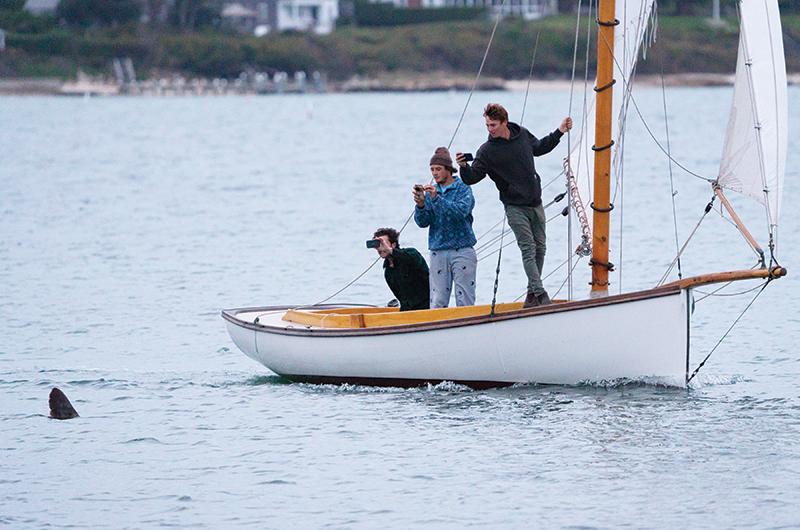
Porbeagle sharks, unlike white sharks, frequent the North Atlantic in the late fall and early winter, Skomal said. They are not considered to be particularly dangerous, and are seriously overfished through much of their range. From video footage sent to him, Skomal determined that the shark appeared to be suffering from some kind of infection.
“I’ve seen these sharks sometimes beach themselves,” he said. “The porbeagle is a cold-water shark, so I expect it to be here almost year-round.”
Its deteriorated condition didn’t stop it from approaching a nearby dog earlier that day.
“I looked more and I thought, ‘That is a big dolphin,’” the dog’s owner, Amanda “Scotty” Borland, told the Vineyard Gazette. “And then, all of a sudden, it whipped back around and this guy was driving over the bridge and he said, ‘I saw the shark coming for you.’ It happened so fast. I honestly couldn’t believe it. It came right up on the shoreline.”
Both Borland and her dog made it out of the water safely. “I thought I was in the middle of Jaws,” she said.
No matter the species of shark, Skomal emphasized that dangerous encounters are not only rare but practically nonexistent. He gave an example of a man on Long Island who had paddled too close to a school of bait fish when a shark was trying to feed.
“If you’re amongst the bait fish and splashing like a bait fish, it’s possible to be bitten,” Skomal said. “The only shark bite I’ve ever seen on the Vineyard was back in the late eighties, when a guy was catching a sandbar, a brown shark, and he grabbed it by the tail and it bit his leg. That was self-inflicted and certainly provoked.
“From a statistical point of view, the likelihood is extremely low,” he added.
Still, even with statistics on their side, the Edgartown Parks Department doesn’t plan to stop exercising caution anytime soon. Other parks departments on the Island, such as Chilmark’s, are on the lookout for sharks of their own, although they haven’t seen any cause for alarm.
As shark encounters become more frequent, the Trustees of Reservations, who manage beach properties on the Island and across the state, offer a glimpse of what future department policies could look like. The land conservancy employs different shark protocols based on the level of contact, from an unconfirmed sighting to a direct attack on an animal or human. In the event of animal predation, such as a shark killing a seal, Trustees Islands portfolio director Darci Schofield said the beach would close for up to a day “to allow blood and remains to wash out of the area.” An attack on a human would prompt a full EMS response, she said, and a multi-day beach closure.
Creato, for all his involvement, doesn’t believe in what he calls the “security theater” of clearing the beach. “The way I see it, if a shark bites you, it’s an accident,” he said.
Soaring over Edgartown, the harbor and the boats that inhabit it had been reduced to swirls and dots of color, the water flat and glossy save for a froth of white trim at the shoreline.
“I like that humanity’s kept a little humbled, although I wouldn’t want anyone to get eaten,” Creato buzzed through the radio. “I like knowing that tigers and bears are out there.”
And sharks.

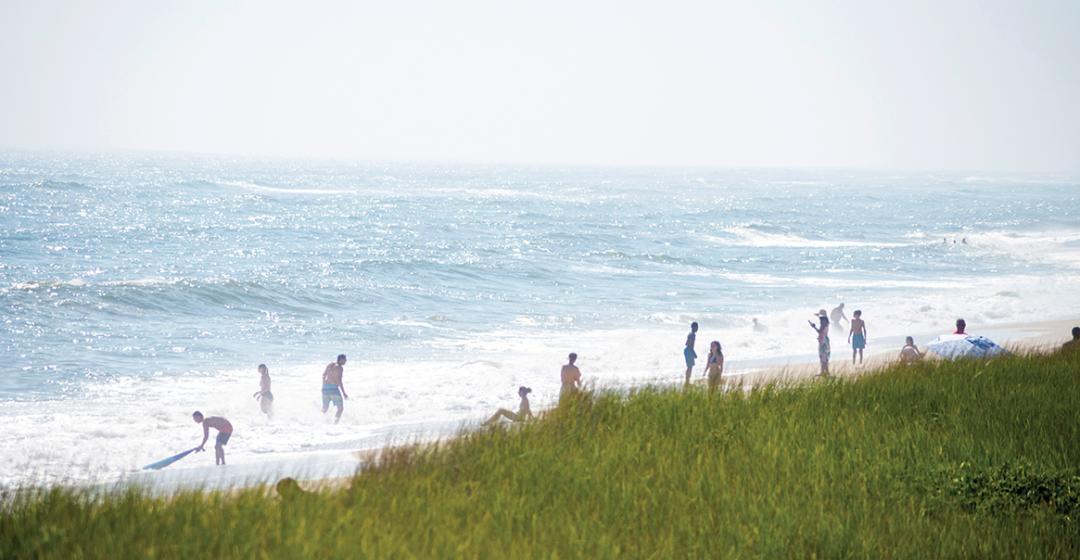


 2 comments
2 comments
Comments (2)